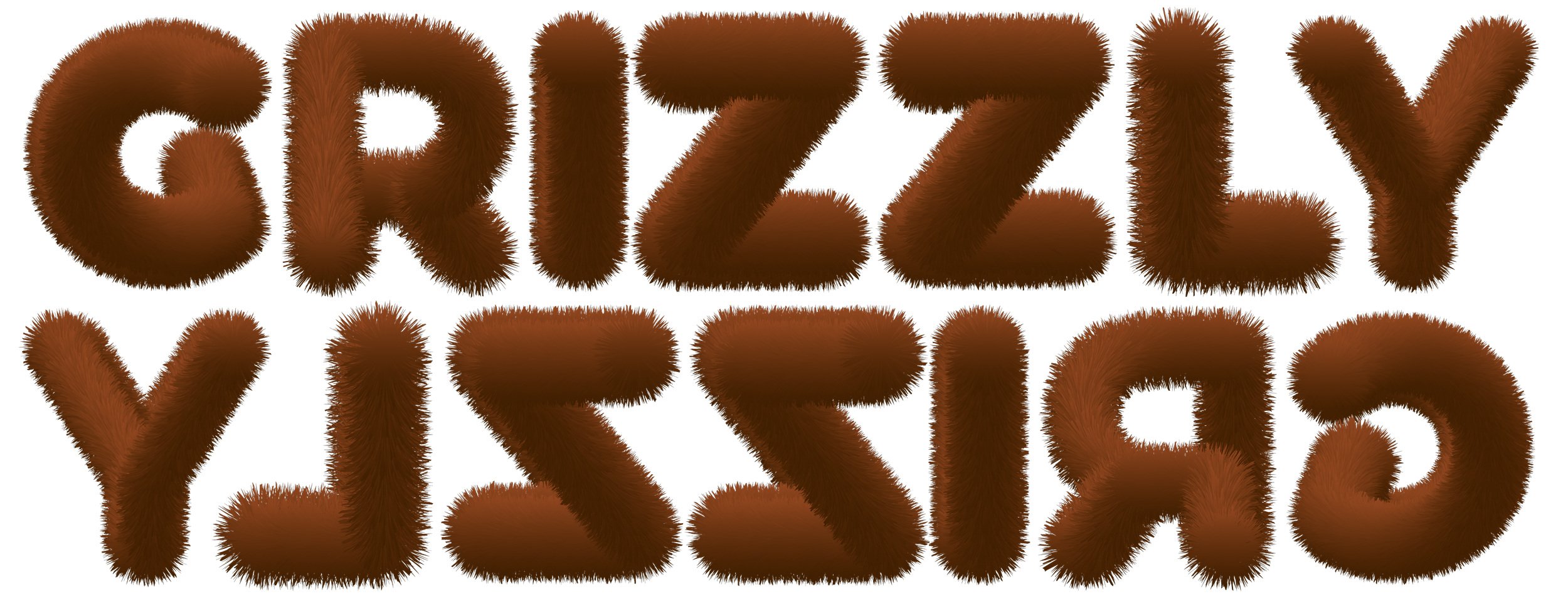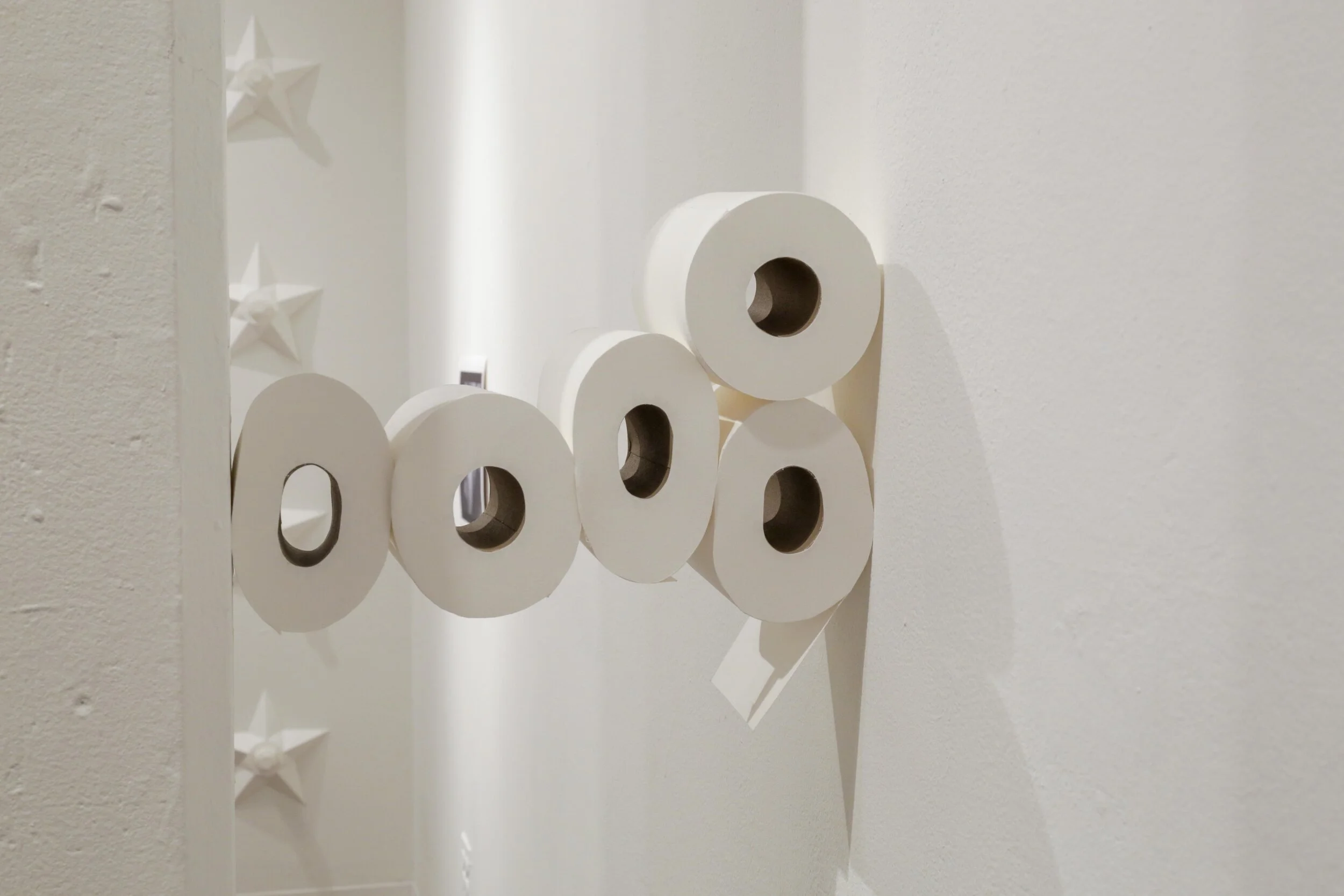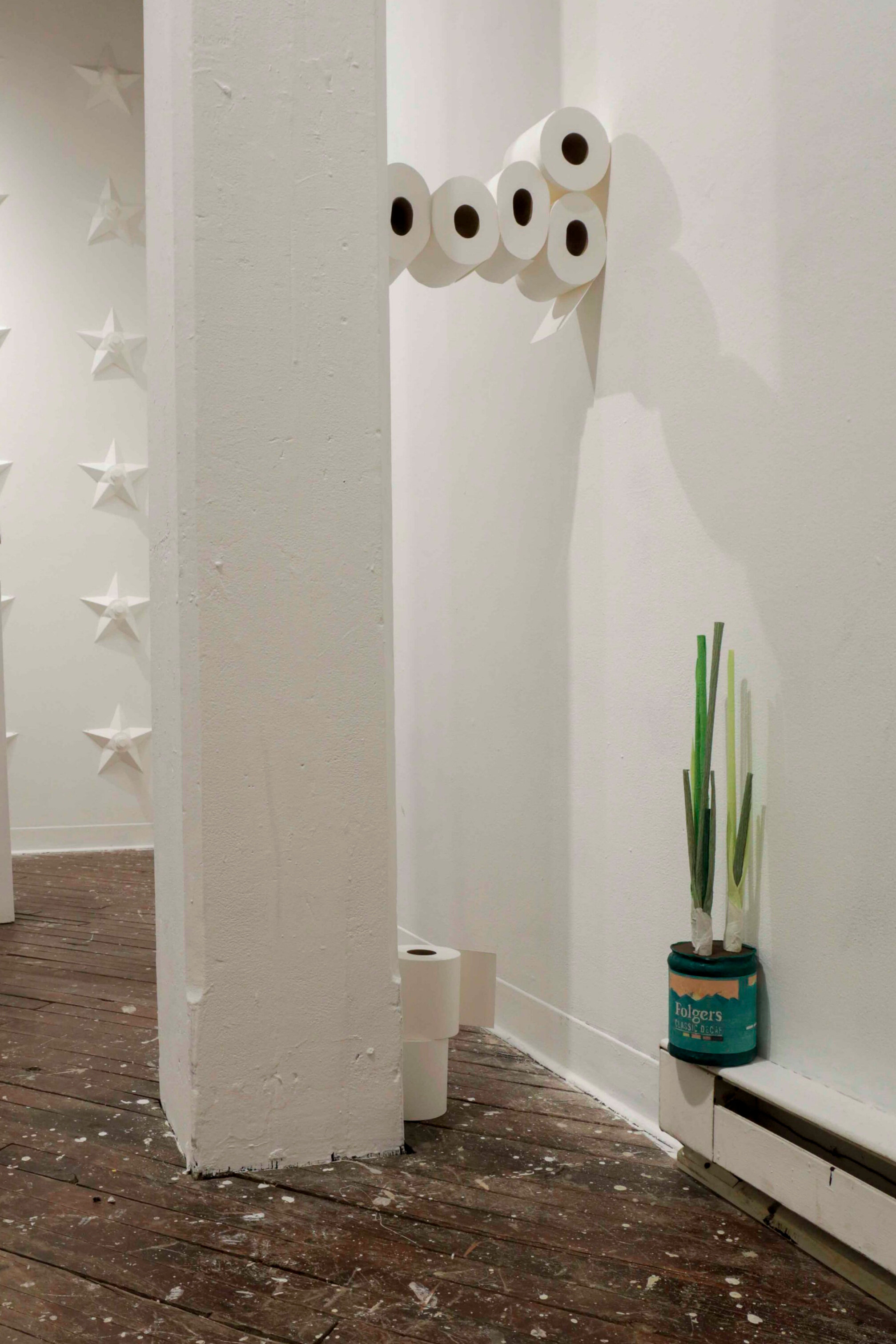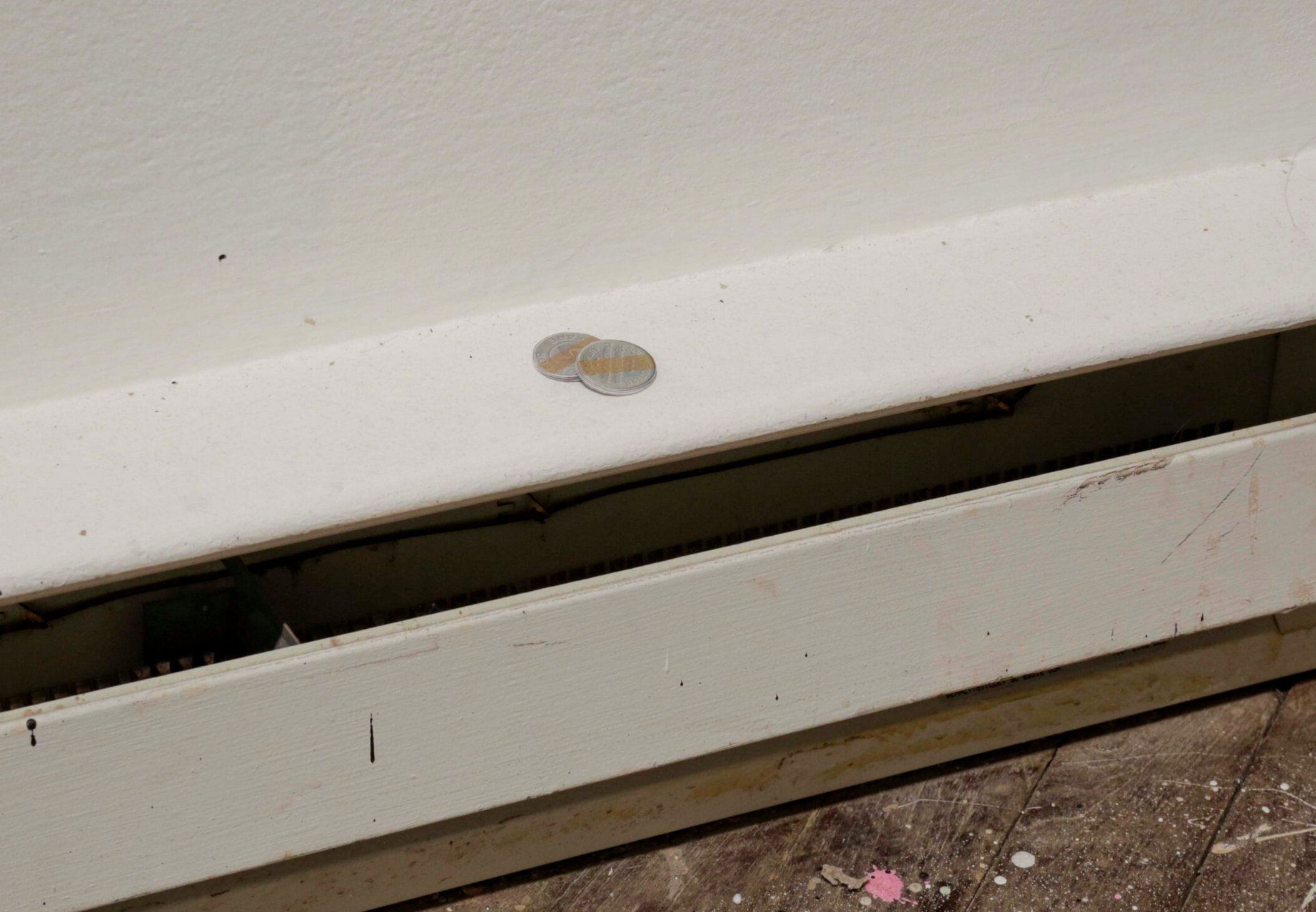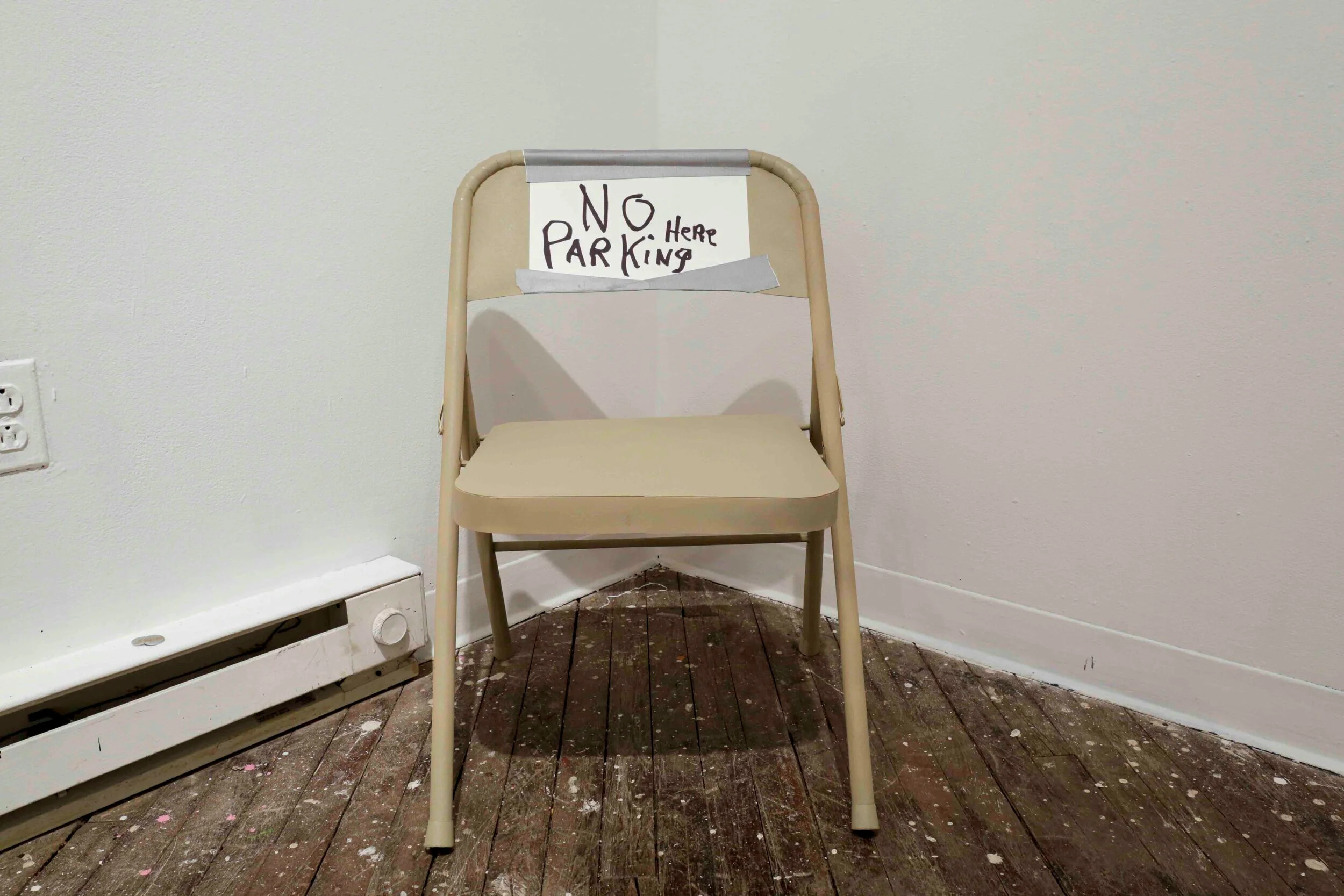Imin Yeh: The Drawer of Extra Sauce, An Essay By Mary Salvante
Imin Yeh: The Drawer of Extra Sauce
An Essay By Mary Salvante
Imin Yeh’s February exhibit, The Drawer of Extra Sauce, is a site-specific installation that consists of hundreds of handmade sculptures built out of paper, often hiding within plain site, laboriously replicated from collections of found objects, everyday detritus, and infrastructure embellishments. Mary Salvante’s essay gives a written tour of Yeh’s world of meticulously crafted paper sculptures. Salvante illuminates the profound ironies, complexities of value and craft, and the deeply personal connections between the artist and the objects she renders.
2020 programming is supported by Added Velocity which is administered by Temple Contemporary at Tyler School of Art and Architecture, Temple University and funded by the William Penn Foundation.
I had the pleasure of chatting with Imin Yeh the morning before her opening at Grizzly Grizzly. I admired her outward enthusiasm and energy, but behind her penetrating eyes her wicked, ironic humor could not be ignored. Humor and play is a powerful magnet in her work and a practice she uses effectively. Once in, Yeh digs deeper, challenging preconceived attitudes related to concepts of usefulness, authenticity, and value.
Gallery Cheese is strategically placed to welcome, or to confront visitors. It's a plate of gallery cheese, the ubiquitous food one finds at any art opening. There is no value other than to be devoured by the masses by the end of the night. But this pile of yellow and white cheddar and jalapeno cubed cheese and plate is made from paper and introduces a narrative thread presented throughout the exhibition–one that questions our understanding of tangible.
Yeh’s interest in replicating objects in paper emerged from her background in printmaking. All of her pieces are built by hand and to scale using one-hundred percent cotton printmaking paper, either Rives BFK, or Lenox 100. Thinner, more transparent paper such as Kozo is used for interior, non-structural forming elements.
Yeh is most interested in common, utilitarian, mass-produced objects that have, or had some level of function either as a tool, food, or some other type of apparatus, but are considered to lack any sustainable value. Through a process of replication, Yeh is reframing the value of objects and by extension asking the viewer to consider the meaning of value, how we assign value, what motivates value, and how value is added, or diminished, when the object is perceived as something needed versus desired. She utilizes several techniques in asserting these ideas such as: placement, scale, space, site, materials, and subject.
Gallery Cheese shares space with Extra Sauce, a drawer full of replicated soy sauce packets–the kind you get with Chinese take out food. They are hidden below the cheese in a fabricated drawer/pedestal combo, which is not made from paper. Its placement is meant to surprise the viewer and instill a reaction of excitement as if discovering a treasure trove of opportunity. What was idly tossed into the drawer to be used at a later time, or forgotten about, is claimed like a prize or reward.
Yeh utilizes printmaking techniques in creating Extra Sauce. Manufactured soy sauce packets are screen printed plastic filled with sauce, designed to be cut and produced as fast as possible. Registrations are off and colors are usually uneven or faded. She scanned the actual soy sauce packet then redrew the image in Adobe Illustrator. She then printed it on Kozo paper and covered it with paraffin wax. The results are a very convincing duplication of a mass produced product, but with corrections made to the printing quality rendering them highly desirable collectables.
Stink Bug in Residence also utilizes screen-printing techniques to mimic the surface characteristics of a stinkbug. Usually found hiding in the most inappropriate places this bug is now in plain sight, up high on the wall taking up way more space than it needs, engendering it as some sort of King of bugs, which adds a humorous, lighter touch to the exhibition.
While these two works are replicated with screened images and graphic elements, many other pieces are created from a minimalist perspective using only white paper without surface treatment or color. Stripped of their utilitarian coding, these objects become admired for their form, volume and orientation. The pure white color suggests the act of preserving, archiving, and mummification, enshrining the object forever, never to fade from memory.
Screw, for example, is actually two 3-inch replicated gallery screws in the wall that at first appear to be real, but have carelessly been painted over as in having so little value that they are not even worth the extra effort to pull them out. Star Bolts is a multiples piece installed in a grid filling the back wall of the gallery. They are based on the architectural hardware commonly used on pre-twentieth century building facades. Usually faded, painted over, and rusted out, Yeh has resurrected them in white paper to be admired and appreciated for their design, structure and pattern.
Similarly, Dogwood Bolts for PAFA is a series of c-bolts found in the ceiling at Pennsylvania Academy of Fine Art, and Light Switches from The Anderson in the front of the gallery placed just inside the door, where you would expect light switches to be, play on the viewer’s assumptions of reality and authenticity. As does Toilet Paper, a site-specific piece made to resolve 14 inches of unusable space between the gallery wall and a column. As an object that is usually white and made of paper, this piece reinvents concepts of purpose. A fragile, short-lived object becomes a structural brace and architectural element. On closer observation the paper used for replicating–the paper–is complete with an embossed pattern and perforation marks. If that isn’t convincing enough, some rolls are made to look squished, compressed by the act of wedging and pushing the rolls against each other to fit between the wall and column creating a more acute level of tension.
There are multiple narratives that inform Yeh’s creative process. Many pieces represent objects that are in plain sight, but unseen. Other objects are impressions of her memories, and others contain narratives pulled from past and recent personal experiences.
Film Projector stands out from the rest for its unique narrative and function. Now considered an obsolete relic of mechanical operation, this piece is fully replicated down to the logo on its side, surface color, a very fine filmstrip made with paper scrolling out the top, and a plug and cord attached to the back. On the wall facing the projector is a digital print representing a film-still from a 1980s educational film about papermaking. The level of detail brought to this piece suggests a reverence for a time when modernist design ruled the day and analog mechanical works were visible and tactile. Yeh was struck by how easily information can be lost when the equipment needed to read it or access it is no longer available. She wanted to preserve the history of the machine and the historical information it provides.
Yeh has also created a number of pieces that have a personal connection and cultural significance specific to Philadelphia. Folgers Spring Onion is a replica of what Yeh happened to see in the window just one house down from the gallery. A sun bleached Folgers coffee can is repurposed as a planter for a spring onion placed on a windowsill. Seeing this object reminded Yeh of a custom common in her Chinese culture, and the memory of that triggered a sentimental and nostalgic reaction. Complete with the Folgers logo and the long, vertical, variegated green stalks for the onion this piece might also have been a nod to neo-Dadaism and pop artists from the 50s and 60s, specifically Jasper John’s bronze sculpture, Painted Bronze, depicting a Savarin coffee can filled with paint brushes.
Yeh intentionally placed this piece on the top of a non-working baseboard radiator. It doesn’t quite sit firmly and is slightly off balance, as it might have appeared when she saw the real thing in the window. This intentional placement forces the viewer to shift perspective, take a closer look, and observe in a different, unexpected way. Sharing space on the radiator is A Sculpture for Your Wallet: Septa Token, which is two septa subway tokens placed as if thrown away, or just dropped by accident, suggesting an indifference to their monetary worth.
The final piece in the gallery is Parking Chair, a life-size paper replica of a metal folding chair with a hand written “No Parking” sign taped to the top surface of the chair back. The sign locates and contextualizes the chair as the household object of choice for Philly homeowners attempting to save parking spaces that they just liberated from piles of winter snow. The sign is intended to thwart efforts by would be parking space thieves, or it is simply a clever solution to discourage gallery visitors from sitting in it.
Yeh’s practice of replication elevates and makes visible common, hidden, seemingly unimportant, and valueless objects. She approaches her work mischievously with humor and play not to deceive, but to inform and engage. In her work and in the exhibition Yeh conjures up ideations of worth, value, and preservation by encouraging reflection on the origins, history, and the physicality of everyday objects.
Mary Salvante is Gallery Director and Curator for Rowan University Art Gallery. Since 2009 she has curated over 40 group and one person exhibitions with internationally noted artists including: Dread Scott, Ebony Paterson, Mel Chin, Joyce Kozloff, Brandon Ballengée, Julie Heffernan, Jamea Richmond Edwards, Diane Burko, and Beverly Semmes. Prior to her work at Rowan University, her practice as an independent public art curator contributed to Philadelphia’s growing arts and culture scene between 2000 and 2008. Now in its 20th year, she founded Philadelphia’s first environmental art program at The Schuylkill Center for Environmental Education. Working collaboratively and in partnership with a community of artists Mary helped transition the Philadelphia Open Studio Tours (POST) from a volunteer-run program into one currently produced and managed by The Center for Emerging Visual Artists, and was the co-founder of Art In The Open, a bi-annual public art event also in Philadelphia. Mary holds a BFA degree from the School of Visual Arts in New York City, and a Master of Science degree in Arts Administration from Drexel University in Philadelphia.
Imin Yeh is based in Pittsburgh, PA. She is an interdisciplinary and project-based artist working in sculpture, installation, and participatory events. Recent exhibitions include university galleries at Ithaca College and the College of New Jersey, San Jose Museum of Art, Asian Art Museum (San Francisco), and at the Contemporary Jewish Museum (San Francisco). She has been an Artist in Residency at Montalvo Art Center (Saratoga, CA), Blue Mountain Center (New York), Sandarbh Artist Workshop (Partapur, India), and at Recology San Francisco. She is a recipient of a Eureka Fellowship from the Fleishhacker Foundation and an Individual Artist Grant from the San Francisco Arts Commission. Imin Yeh holds a MFA from the California College of Arts. She is currently an Assistant Professor at Carnegie Mellon University School of Art.
